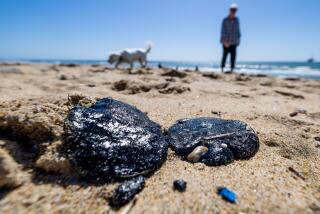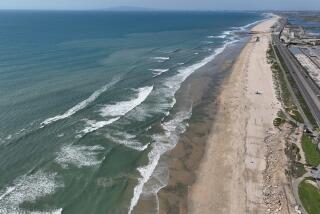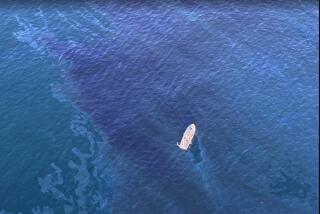How theyâre fighting the oil spill
Reporting from Dauphin Island, Ala. â The oil swirling in the Gulf of Mexico â broken up by dispersants and churned by winds and currents â has become an elusive giant, increasingly difficult to clean up but presenting a smaller, scattered threat if it reaches shore, U.S. Coast Guard Commandant Adm. Thad Allen said Friday.
âThis spill is changing in its character,â said Allen, President Obamaâs top commander in charge of responding to the spill. âI donât believe any longer that we have a large monolithic spill.â He said the roughly 60-mile-long, 100-mile-wide slick has separated into patches of oil with water in between.
âThere is good and bad news in that,â Allen said. âThe bad news is the oil is very widely dispersed, and itâs hard to kind of manage the perimeter. But on the other hand, if there are shore impacts, it will come to shore in smaller quantities that are basically subsets of what might have been a larger spill.â
Given the changing nature of the 3-week-old spill, an effort is underway to evaluate cleanup strategies and more precisely answer this question: âBetween incendiary burning, mechanical skimming and dispersant application, what have we done?â Allen said.
On Friday, the slick was skirting the coast of Louisiana and the Chandeleur Islands chain. Thunderstorms and strong winds forecast this weekend are expected to hamper cleanup work.
Scientists gave mixed views on the adequacy of the work so far.
âOverall, the cleanup effort is certainly making a difference, although the exact degree of oil recovery is hard to quantify,â said Julius Langlinais, professor emeritus of petroleum engineering at Louisiana State University. âIn addition, a good portion of the oil out there is evaporating.
âThis is not like the Exxon Valdez disaster in Alaska, where the water was cold and spilled oil was heavy,â he said. âHere, the water is warm and the oil is of a lighter variety. With evaporation, the heavier parts of it will fall to the bottom of the ocean as asphalt.â
Dec Doran, an oil spill consultant who worked for Exxon during the 1989 Exxon Valdez spill, was not as optimistic.
Oil may have dropped to the bottom, he said. And much of the oil on the top can be expected to elude some booms and skimmers even in good weather. âIf you can contain and recover 20% of this oil, youâve reached the maximum efficiency of booms and skimmers,â said Doran, who has worked on more than 2,000 spills.
A few experts, however, said at this point, the cleanup is all but futile.
âYou can have the best plan in the world, but most of the toxic shock will be done regardless of the most Herculean effort,â said Rick Steiner, a marine conservation consultant in Alaska who worked on the emergency response effort in the Exxon Valdez spill.
With response teams on a war footing in the gulf, more than 500 vessels have scooped up roughly 3.6 million gallons of oily water. More than 200 miles of booms have been deployed and about 517,000 gallons of dispersant sprayed from military cargo planes. About 378,000 gallons of oil has been corralled and burned at sea.
Cleanup crews have attacked the slick with a variety of weapons: fire, skimmers, dispersants, booms, sponges and sandbags:
â¢Fire: The most effective method of destroying spilled oil is a controlled burn. Essentially, the strategy uses special U-shaped âfire boomsâ towed by vessels to corral portions of oil and move it to a safe place for burning.
But rising winds and 4-foot swells have made controlled burns difficult. Authorities have conducted only five since April 20, according to BP spokeswoman Rebecca Bernhard.
â¢Skimmers: These are vessels that sweep oil off the surface using a variety of methods, including absorbent âconveyor belts,â massive spools of rope and rotating discs that attract oil and repel water. Like burning, skimming is limited by windy conditions and choppy water.
Oily water collected from skimmers is squeezed out of collection devices and funneled into tanker vessels. The oil is extracted and processed into fuel, but about 90% of the material hauled up by skimming boats is water.
â¢Dispersants: Detergent-like oil dispersants have been dropped by planes to help break down the slick into droplets and allow it to degrade more rapidly. As of Friday, 192 missions had been flown, each covering more than 250 acres, BP said.
Dispersants have been used on smaller spills elsewhere, but never to this extent in U.S. waters, federal authorities said.
Environmentalists worry about the possible toxic effects of releasing such a large volume into the gulf, which has critical breeding grounds for fish including bluefin tuna. But federal officials contend that dispersants are much less toxic than oil and are considered a necessary tradeoff to try to protect the coastal environment.
On Friday, federal regulators approved an experimental plan to inject chemical dispersants into the oil gushing from the wellhead 5,000 feet underwater.
â¢Booms and sponges: Locally hired crews in their own boats are among the crews lowering sponge-like materials into the water to soak up the oil. The sponges are packaged in garbage bags and returned to land. But that method is slow.
Fisherman and others are also working to lay rings of hard booms, which are made of a durable PVC material, to prevent oil from washing up on shore.
But because the oil is sprayed with dispersant, it mixes in with the water and can drift beneath the booms. High waves and winds have also knocked the booms underwater or washed them ashore.
Booms were laid on the beach where dime-size globs of oil washed up at South Pass in Plaquemines Parish, La., on Wednesday. Local governments have complained of boom shortages; BP orders the material from as far away as Brazil, Norway and Alaska.
â¢Sandbags: To make up for boom shortages, Louisianaâs Lafourche Parish worked with the National Guard to drop more than 200 one-ton sandbags on coastal areas where beaches had eroded and rivulets ran inland. But high waves and tides knocked over the sandbags, making them ineffective. The sandbag campaign was abandoned Thursday.
Time and nature also are influencing the behavior of the oil, which scientists said was being pushed and pulled by currents, and dissipated by evaporation.
âThe more weathered, the more broken up the oil is, the more likely the impact on the shore will be more scattered,â said Doug Helton, incident operations coordinator for the National Oceanic and Atmospheric Administration. âThe smaller the chunks of oil, the more biological degradation can occur.â
Eric Terrill, director of the Coastal Observing Research and Development Center at the Scripps Institute of Oceanography, which has helped track the spill, said that it is not growing like a large puffy cloud. Instead it is being carried beneath the surface, making it difficult to contain and recover the oil as it spreads throughout the water.
Terrill said he is certain the oil will get into the Loop Current, a strong flow that would bring it to the Florida Keys and around to the East Coast. âItâs just a matter of when,â he said.
More to Read
Sign up for Essential California
The most important California stories and recommendations in your inbox every morning.
You may occasionally receive promotional content from the Los Angeles Times.













